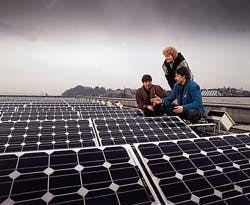BP to expand solar energy technology, market share
Solar panel technology used on a school rooftop in Switzerland is explained by engineer Matthias Sodeik. Photo courtesy BP.BP Solar Inc., in a move to expand BP's $100 million/ year worldwide solar photovoltaics business tenfold, is embarking on a major business segment initiative.
Leveraging off a 1996 acquisition of the assets of Advanced Photovoltaic Systems at Fairfield, Calif., BP is advancing plans to open what it says is the world's largest and most modern solar manufacturing plant of its kind at Fairfield.
The existing idle complex, totaling 65,000 sq ft, is being converted to BP specifications and will be used to ratchet up BP Solar's presence in and outside the U.S., with the company aiming for $1 billion/year in total solar energy sales within 10 years.
"By 2000, we plan to have 50 MW of capacity," said Richard Sowter, BP Solar president. "Last year, the total world capacity (from solar photovoltaics) was about 85-90 MW."
BP Solar, which has been involved in solar energy for 15 years in Europe and many other locations, will use Fairfield as its U.S. headquarters. During the next 12 months, BP plans to invest about $20 million for retooling and commissioning activities at the Fairfield plant.
BP's global activities
BP reports sales from solar energy activities grew by 22% in 1996, and the company aims to leverage its position by concentrating on applications for solar that offer high value and growth in consumption.
In addition to the California complex, BP intends to expand its silicon cell manufacturing capacity in Spain. Capacity doubled in 1996, and BP plans to redouble that in 1997.
Also, it has commissioned a manufacturing line for solar cells in India.
BP says the cost of production of its solar photovoltaic panels has declined dramatically since the 1980s, and the company estimates they will halve again by 2000. In the early part of the next century, providing costs continue to drop, BP believes solar technology costs will be close to or approaching baseload electric power costs for conventional energy sources.
In Japan, where electric energy costs are about 25¢/kw-hr, BP reports the government is subsidizing the technology at 50% of the cost of the panels initially. BP reports Japanese officials theorize that if 50% of Japanese homes are equipped with solar panels by 2010, then conditions for mass production will be achieved and costs will be halved.
By 2010, presuming millions of solar panels have been installed, the subsidy can be eliminated.
A similar scheme in Germany, which started out as part of a 2,500-home pilot project, has been widely accepted, and BP says the solar panel market in Germany-where BP has a 25% market share-has skyrocketed. In 1996, BP's sales in Germany soared by 60%, with the rest of the market increasing at a 25% rate of growth.
Technology advancing
Presently, about 40% of the cost of photovoltaics is linked to silicon, causing the technology to be held hostage to cyclical demand. So BP is seeking to move the technology away from reliance on silicon.
BP is developing a new, proprietary technology it calls Apollo, using thin-film, tin oxide-coated substrates.
Although at 8% efficiency, it's not yet up to BP's 17% efficiency level with silicon, but advantages include producing photovoltaic cells at lower temperatures and lower cost.
Uses could include powering satellite communications, and the British Defense Research Agency is now testing the ability of thin-film technology to withstand intense ultraviolet bombardment in space.
The technology is now used for cattle fences in Australia.
BP's 1996 acquisition of Advanced Photovoltaic Systems will be used as a base for mass producing Apollo.
Copyright 1997 Oil & Gas Journal. All Rights Reserved.
